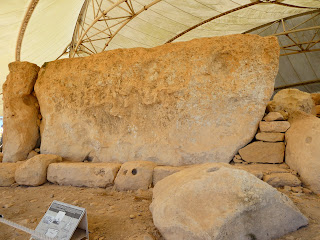(Before I get into the whole temple business, the photo above is of a labyrinth that we encountered on our very first day out. After scoping out the inside of the Ta Pinu Shrine, I promptly went back out and walked this labyrinth before everyone else came out of the church. What a magical omen for the start to a great trip!)
I am utterly fascinated by megalithic structures. They are found all over the world, on land and also off shores when their locations were flooded by rising sea levels after the last Ice Age. Dating these sites is difficult because back then there were no written records, and stone cannot be carbon dated. Archaeologists do the best that they can with that. I suspect, but cannot prove that most sites are older than researchers think that they are.
I have been to many megalithic sites, including Stonehenge, Avebury, Carnac, Gobekli Tepe, and all over Peru to name a few. When I learned about the megalithic history of Malta, I had to go and see for myself. If you are interested, I encourage you to do some research. An excellent book is “Malta & Gozo, a Megalithic Journey “ by Neil McDonald.
Those ancient people were very in tune with the cosmos, so most of these sites were aligned with solstices and equinoxes. Certainly, ceremonies were performed at these times of year, but what they consisted of, we do not know. The sun and moon, planets and stars were magical beings to them. The society’s “shaman” was in charge of these aspects of community life.
According to archaeologists, the Temple Period here goes from 4100 B.C. to 2500 B.C. at which time the islands were mysteriously abandoned. There were indications of human presence on Malta going back at least to 8000 B. C. and even earlier, so people were there before the temples were built.
There are about 35 locations where the temples are still mostly intact or partially intact. There are an additional 30 locations where some remains have been documented. Most of this destruction happened when areas were farmed or houses were built and the temples were destroyed in the process. It is also important to note that through the many thousands of years after the Temple Period came to an end, all of these locations were gradually covered over with soil by the natural processes of wind and weather.
Our group visited 4 of the most important temples. The general layout for each consists of a central corridor with 2 or 3 pairs of rooms on each side leading back to the sacred area, or Holy of Holies. Kind of like a four leaf clover design. I used my pendulum to test each temple, and found all of them to be highly energized with the most energy at the very back. Below is a diagram of the Ggantija Temples
The alignments of the central corridor are a very interesting matter. From the back of the temple looking down the corridor and out the very front, all of them are pointing in some variation either southwest or southeast. In her book, “Sirius the Star of the Maltese Temples”, Lenie Reedijk lays out the proof that starting in 9150 B. C., each temple was aligned with either the rising or setting of the star Sirius. That explains where the various temples were situated, to take advantage of this bi-yearly event. This also puts the Temple Period back 5000 years! Of course, there is more to this, but you have to read her book to get more of this fascinating story.
So here are some photos of the temples. First there are the Ggantija Temples, the only ones not covered by a canopy.
Next, the Tarxien Temples. These are the best preserved, and my favorite energetically.
On the next to the last day, we first visited the Hagar Qim Temple.
Lastly, the Mnajdra Temples. Both this one and Hagar Qim are situated close together and on a rugged and scenic rocky slope leading down to the sea and a view of tiny Filfla Island.
Here is Filfla Island.So this is the big post. More photos to come.



































I love the curved layout of the temples. This is so different from most other megalithic sites that appear to be so linear and perpendicular. The curves feel more feminine and that they are aligned with Sirius, a feminine energy star system, that makes sense.
ReplyDeleteYes. Perhaps an association with Isis. The Egyptians worshiped Sirius, too.
DeleteThank you Carla. It’s wonderful to relive our trip through your eyes!
ReplyDeleteThank you!
ReplyDelete